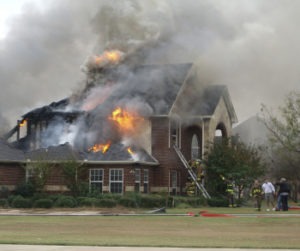Smoke Damage: How it Can Hurt Your Home
Smoke damage can wreak havoc on your home, but how? Read on to learn more.
 A new house fire is reported to fire departments about every 24 seconds. Fires cost thousands of civilians their lives each year and do costly damage to homes and nearby buildings.
A new house fire is reported to fire departments about every 24 seconds. Fires cost thousands of civilians their lives each year and do costly damage to homes and nearby buildings.
Fire and smoke damage is severe, and you’ll want to act fast to get rid of the smells and stains before they become permanent. Homes that survive a fire need an inspection as soon as possible to quickly determine recovery options.
If your house is still intact after a fire and you wonder what your next steps should be, keep reading! After getting clearance to return, and after contacting your insurance company, your next best move is to see what has to be thrown out. While you search, keep an eye out for the following tell-tale signs of fire and smoke damage. Below, we’ll also provide a few potential solutions to restore your home.
Fire and Smoke Damage: Common Problems and Their Solutions
Fires are already a dangerous hassle without mentioning all the headaches that follow. Last year in the U.S. alone, fires cost $23 billion in repairs. Not everyone is so fortunate to still have a home standing to repair after a fire breaks out. If you are, know that you may encounter a few of these hurdles to restoring your home.
Weakened Structure
We all know that fire can do a number on wooden beams and drywall, but it can also warp metal frames if temperatures become hot enough. Fire can damage concrete and cause it to expand and crack. The exposed layers will burn and swell more quickly, which may cause the outer layers to break off, eventually leading to an unsound structure.
Structural damage is no joke, and walking into a home without a proper clearance from an authorized inspector can easily cost you your life. Ceilings can collapse, floorboards can turn to ash under your feet, and walls could cave in around you. This is why victims of a house fire must have building inspectors check out the foundation and the structure. In places where a structure is considered weak, inspectors may suggest an engineer or an architect.
Stained Furniture
Sometimes a house fire will consume all the furniture, leaving only scorched remains behind. Furniture that has escaped the burning and singeing will still have a strong smoke smell trapped inside its material. Check each furniture piece over for charring or singed fabric. If it passes, use these quick tips to get the smoke smell out:
Fabric: Supermarkets typically carry fabric-cleaner on their shelves, and you’ll want to find the most heavy-duty product available. If you’re more interested in home remedies, use baking soda, or a blend of water and vinegar.
The baking soda will help lift and consume the cause of the smell. Vinegar and water will help terminate the smoke odors, but may leave a sharp, sour scent behind for a little while. Use this method outdoors if you can.
Leather: Leather is a lot tougher than most fabrics, which means you’ll be able to use a slightly harsher cleaner (diluted with water). First, though, you need to remove any of the dry or oily smoke and ash residue with a brush or vacuum.
After the surface is cleared, mix together a small portion of ammonia with water (look online for exact measurements for your furniture), and wipe clean. You might want to follow up with a leather conditioner to avoid drying the material out.
Wood: Wooden furniture like coffee tables and end tables are susceptible to smoke damage just like your couches and chairs. You’ll want to take a light brush to the wood to remove any soot or debris from crevices. Next, do a mild wash.
Some suggest using a bleach and water solution, but a designated wood cleaner would undoubtedly work best. You’ll likely need to refinish the surface once the smoke damage is removed, or at least recondition it.
For more information on professionally removing odors from the interior of a home after a house fire, check out the resources here from BMS Cat.
Discolored Walls and Ceilings
Fire and smoke are very likely to stain the walls and ceiling of any room they spread to. If you’re lucky enough to have a home to return to, cleaning off soot, ash, and smoke stains from the walls and ceilings doesn’t seem like such a chore.
Homeowners must clean the walls and ceiling carefully to avoid damaging the materials and causing more harm. Oversaturating drywall or other wall materials can cause it to mold or fall apart. Use a damp cloth for as long as you can, removing as much of the discoloration as water will let you. From there, you’ll have to research which cleaning chemicals will help remove stains from your material type while keeping them unblemished.
Wallpaper is especially tough to restore without messing up the pattern or design underneath. A simple water and cloth scrub will work best here since bleach, ammonia, and other chemicals will stain or possibly disintegrate wallpaper.
Resources and Answers at BMS CAT
Damages from fire and smoke are severe, and surviving a house fire is a dizzying experience. But there’s help and resources online to help you get back on your feet.
Check out other insightful industry tips and advice from the professionals at BMS Cat. Check out their website today to learn more!
